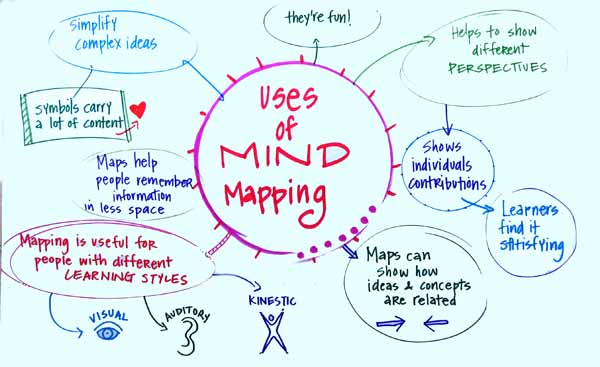A mind map is a diagram used to represent ideas, tasks, or other items related to a central key word. Mind maps are used to generate, visualize, structure, and classify ideas. They're an an aid to organizing information, solving problems, planning, making decisions, or brainstorming.
By presenting ideas in a graphical, non-linear manner, mind maps encourage creativity in brainstorming. They can also display a lot of connected or related information in a one page format.
You can use a mind map in many ways - as an info-graphic, as a to-do list, or as a speech or writing "outline." Take a look at the examples below.
Here's a pretty elaborately drawn mind map of the topic of Creative Intelligence by Alan and Amy Burton:
Here is a more simplified version of a mind map - this is just someone mapping out what they need to do to prepare for an upcoming trip:
And here Mark Jaffer shows his mind map of a sermon he preached: Jaffer's sermon mindmapping.
So what can the mind-mapping process help you do?
55 Possible Reasons to Mind Map
- Explore a subject
- Study or learn a new topic
- Plan your schedule
- Innovate or invent
- Expand existing ideas
- Consolidate your existing knowledge
- Summarize your skills
- Plan your career
- Plan your learning
- Outline your business, or a potential new business
- Outline your writing
- Outline your goals or hobbies
- Study for, and pass exams
- Boost your memory
- Unlock your potential
- Solve problems
- Increase motivation
- Take notes and create overviews
- Develop your creative thinking
- Plan speeches or presentations
- Fire up your imagination
- Clarify your thoughts
- Simplify your life
- Summarise your budget
- Create targets
- Teach others
- Improve thinking skills
- Control time management
- Plan story writing
- Plan an event
- Summarize books you read
- Catalog your past experiences
- Plan a party
- Take meeting minutes
- Investigate what makes you happy
- Investigate what makes you unhappy
- Discover what you want to do with your life
- Plan a blog post
- Summarize an event, like a wedding
- Plan a website
- Pinpoint your values
- Unlock associations
- Pinpoint your goals
- Outline daily tasks
- Create teaching overviews
- Plan and present your resume
- Create year summaries
- Investigate lessons learned from failures
- Summarise content of sermons or classes
- Meal planning for the week or month
- Plan a diversified exercise regime
- Create a journal of self discovery
- Plan Christmas gifts
- Organize your life
- Shift your thinking from "left brain" to "right brain"
Finally, here is a mind map on reasons to mind map. Google the term to learn more about it. You'll discover there are several mind mapping software programs out there. Here is a review of over 50 of them by CNET. But paper and pen works just fine too. So why not give it a try?



I love this! I'm a list maker by nature but I like the idea of doing it in a more graphic way! Thanks!
ReplyDeleteGive it a try Amy! Often people will use mutiple colors on their map ... using color as well as lines to group realted pieces or tasks together. But plain old black ink on white paper works well for me in most cases.
DeleteThanks for the comment.